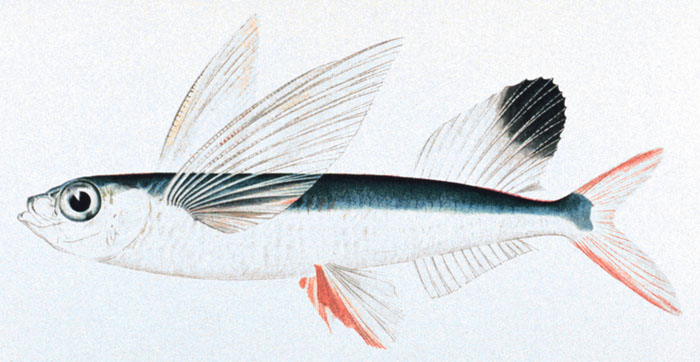Flying Fish
To the fascinating Museum of Water today, where visitors donate vials of water, usually with a story attached, for public display. My favourite was probably the “condensation” (gob) emptied from brass instruments after a concert.
Samara and I made a donation (water from a little canal that runs alongside part of the River Kelvin in Glasgow) and were interviewed by a performer/attendant called Mary. She asked how we met, which brought us onto New Escapologist.
She said that a previous museum visitor had been talking about flying fish and how their flight is a mode of escape.
Apparently they have trouble with boats and tend to fly right into them, either smacking into the bulkhead or landing (and dying) on the deck.
Isn’t that sad? In the natural state, the flight of the flying fish is probably a perfectly good means of escape from predators. Only the unnatural addition of boats to their world has made it futile.
We all agreed this was a fitting metaphor, and that Escapologists will come across our equivalent of seafaring boats: immovable obstacles (bureaucracies, usually) that will scupper escape.
Doesn’t mean we shouldn’t try though, does it? Let’s feel the wind beneath our fishy fin-wings! Bugger the boats! At least we’ll have tasted the thrill of flight!
My recurrent line about how Escapologists, if forced to return to office life, “will at least have something to talk about at the water cooler” brought our conversation neatly back to H2O.
So let’s adopt the flying fish as the Escapological totem animal. Let’s work it into our coat of arms. (Or fins).
★ Buy the latest issue of New Escapologist at the shop or pre-order the book.
In the Interstices
Harry Eyres files the last two installments of his “Slow Lane” column in the Financial Times. In one he writes:
Over-strenuous efforts to get away from it all tend to defeat their object: you encounter the same problems on arrival. The point is to find and enjoy the oases of peace that are freely — and I mean often freely — available in the interstices of the daily round: those easily forgotten or ignored oases, the familiar painting (which you could make a date to spend an hour with) or the poem you half-remember (which you could learn by heart), the pair of bustling blue-tits in the garden laburnum you have hardly noticed for years, the conjunction of Saturn and Jupiter in the night sky, a mode of transport which facilitates richness of experience rather than bullet-like translation from A to B.
And in the other:
My ambition has been to set out a workable alternative to the romantic escapism of Yeats’s Lake Isle of Innisfree. We can enrich our necessarily limited time by learning a short poem by heart, or even writing one; by returning to those viola or clarinet studies we gave up as teenagers, and finding that we can engage with the music in a deeper way and make it our own; by popping in to a museum or gallery to see not a vast, intimidating blockbuster exhibition but just one dearly loved painting; or by playing, at whatever level and with whatever physical limitations, a sport you love rather than watching overpaid narcissists on TV.
I’ve enjoyed his column. Cultural references, being in the FT, were sometimes a little highbrow for my immediate understanding but the ethic behind the column was always extremely sound. Certainly worth a leisurely stroll through the archives.
★ Buy the latest issue of New Escapologist at the shop or pre-order the book.




